Lingcod are massive fish that are frequently caught while halibut fishing. This is because the fishing tactics and location are very similar for both types of fish. Lingcod looks like a cross between the eel-like fish called a ling and a pacific cod. This is likely how it got its name however it is actually not in the ling or cod family. This article will talk about the different types of cod as many people confuse lingcod with pacific cod or Alaskan pollock which are frequently used for fish sandwiches.
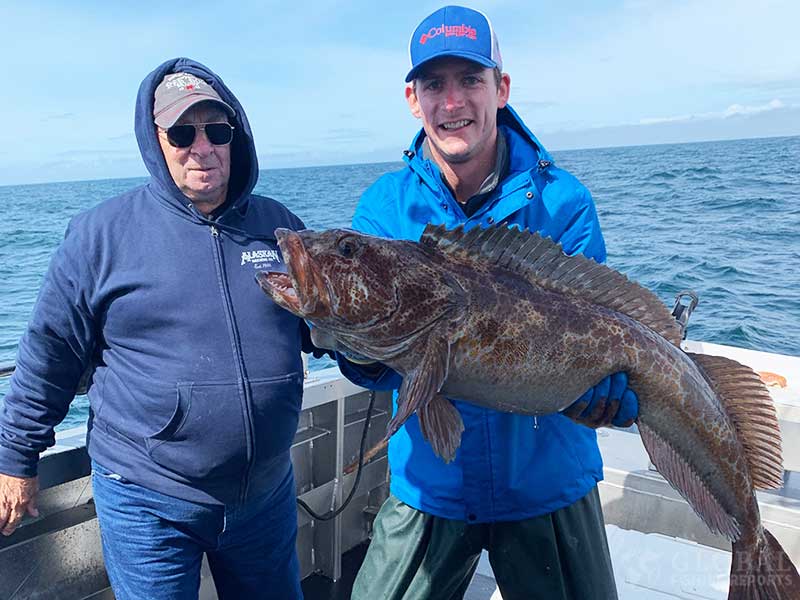
I have caught lots of lingcod in Alaska when fishing for halibut and salmon. The large ones are often called sea dragons since they are so huge and have a dragon-like appearance. These fish have large teeth and massive mouths. It is not uncommon to catch a large rockfish and then have a lingcod bite and hold onto it the entire way to the surface even though it is not actually hooked.
Lingcod Baits
Octopus and Squid
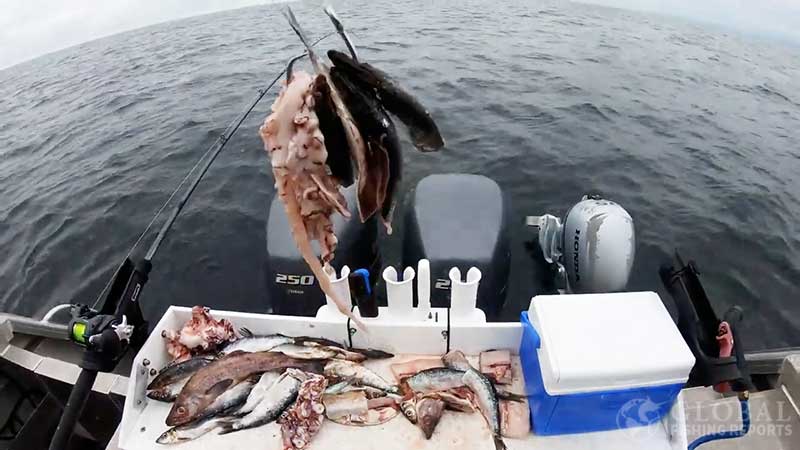
Octopus and squid are great baits for lingcod. The best bait for lingcod is octopus but this is not a bait that is typically used because it is expensive and difficult to get. In the picture, I am using a piece of octopus tentacle and herring as bait on the hooks. We actually caught a huge lingcod that spit up a pacific octopus tentacle. I decided to use it as bait and caught a bunch more fish with it including some large halibut.
The lingcod was caught using herring and pollock. You can catch lingcod on most fresh dead baits. The real key to catching lingcod is location. Some spots I anchor at have lingcod and others do not. It seems very structure-specific in my experience. In this case, it was on the edge of a sand flat and rocky structured bottom. This was a unique spot because it was good for lingcod, halibut, king salmon, and yelloweye rockfish.
Pink Salmon and Salmon Guts
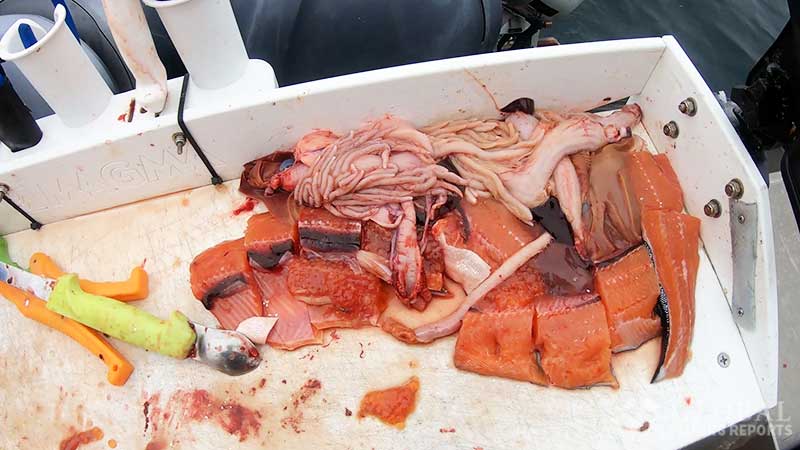
Pink salmon and salmon guts are great bottom baits. This is typically used for halibut but lingcod will certainly bite with fresh salmon or salmon guts. Salmon fillets are not typically allowed to use for bait. However, you are allowed to use pink salmon for bait in Alaska. This is nice cause they are affordable to buy and plentiful to catch in many areas. If you start out trolling for salmon and have success then the guts end up being very useful for bottom fishing the second half of the day.
Herring and Pollock
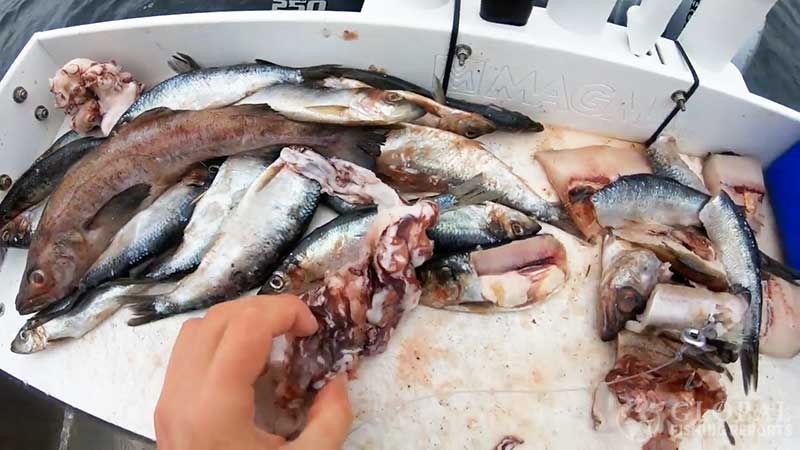
Herring and pollock are typically the baits used early in the season for halibut and lingcod fishing. This bait is sent down while anchored up so that a scent trail can be established. Halibut will follow the scent trail from miles away and lingcod will follow a scent trail to some degree as well. For example, the baits can be reeled 10-15 feet off the bottom and not affect the catch rates of lingcod according to Alaska Fish and Game.
This is nice as baits that are right on the bottom are more likely to catch rockfish and skates. For this reason, once that bait hits the bottom it is a good idea to reel it up about 5 cranks. This will also help the rig from getting snagged as the boat rocks in the waves.
Lingcod Fishing Rigs
Large Circle Hook Rig
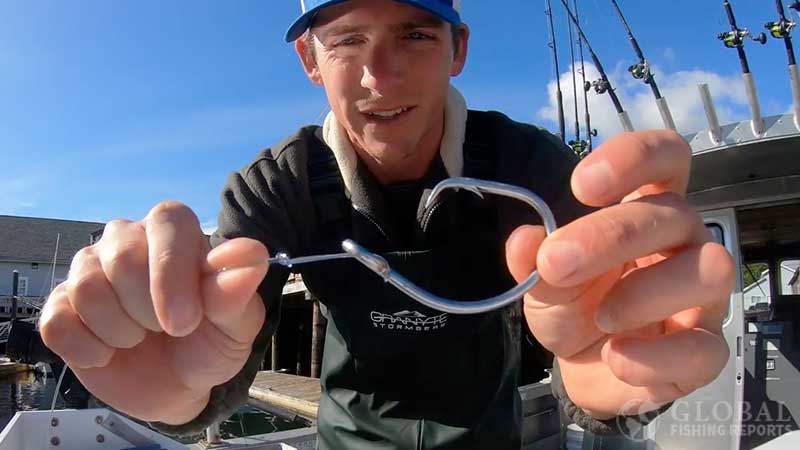
Using a large circle hook with fresh bait is the best way to catch lingcod. Jigs will work as well but fishing with bait is much easier. Lingcod are typically on the bottom of the ocean in rocks or structures where they wait to ambush rockfish, pollock, octopus, squid, flounder, sand lance, herring, prawns, or any other fish that are in the area. A circle hook works well with the bait off the bottom because as it swims back down the hook sets in the corner of the mouth. In the video below I show a great way to secure the hook to the line with a loop knot.
In the video above I show how to make halibut rigs which are the same as lingcod rigs. Using a loop knot to secure the hooks allows for a good hookset. Lingcod get hooked much easier than halibut cause their huge mouths can chomp down easily on large baits.
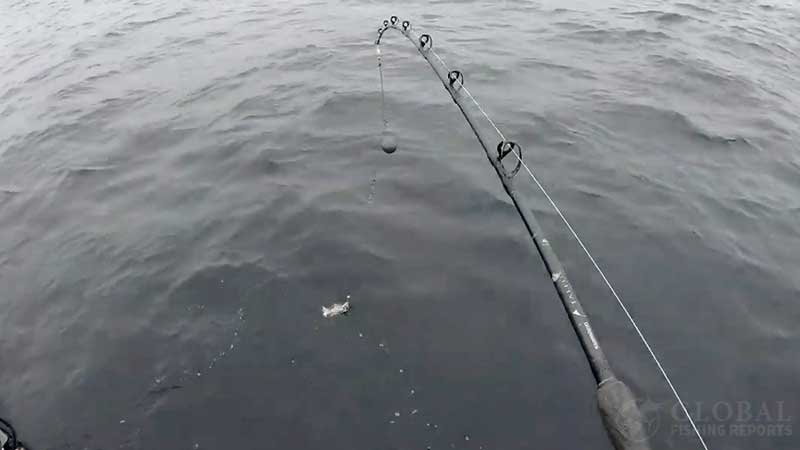
The picture above shows the rig being used. This bait here is almost gone and needs to be swapped out. A 2-pound weight is attached to the rig using a large swivel. The top of the rig is made with a 150-pound braided tuna leader. A 100-pound monofilament line is used to attach the hook using a loop knot. The other side has a barrel swivel which connects to the top leader with a ball bearing snap swivel.
Line Types
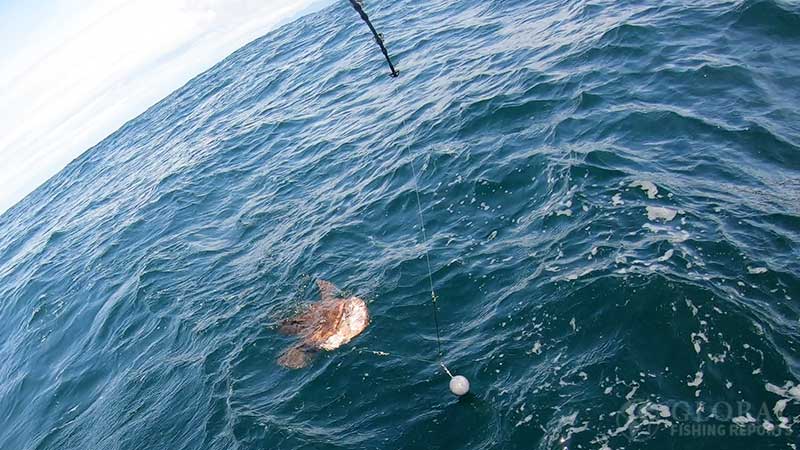
In the picture above you can see a large lingcod at the surface of the water. It is always exciting to see the large open mouth of the fish. Here you can see all three line types. The mainline on the conventional reel is 100-pound white power pro braided line. The next leader is a green 150-pound Ashaway tuna leader. This is often referred to as gangen line and other braided nylon lines will work as well. Finally, a one-foot section of a 100-pound monofilament line is used. This rig can be dropped quickly to depth and still not get tangled. This rig is way easier to use than halibut spreader bars.
Weights and Jigs
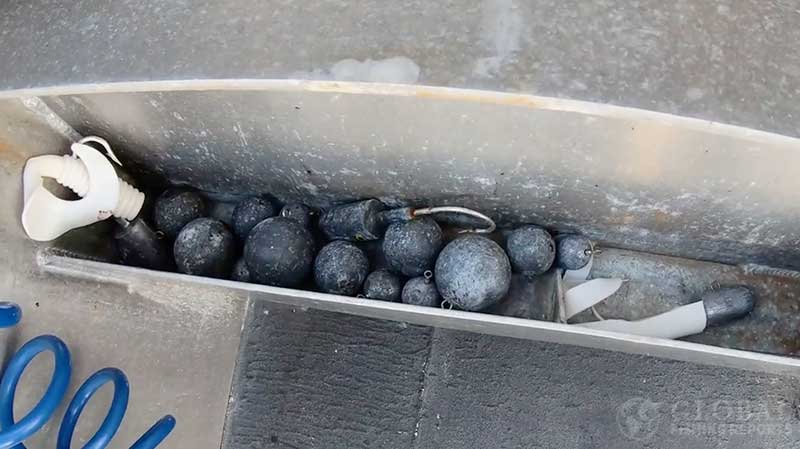
Weights for lingcod fishing depend on the depth and strength of the current. In water, less than 100 feet deep with a low current an 8-ounce weight may be all that is needed. Typically though I am fishing in water over 200 feet deep and I like to use round 2-pound lead weights. This keeps the rig near the bottom and is easy enough to reel in. Sometimes a 3-pound weight is needed but this makes it much more difficult to reel in even when a fish is not hooked. Jigs that weigh between 8-24 ounces can also be used. However, jigging near the bottom requires more work and can result in getting snagged on the bottom.
Mooching Rigs
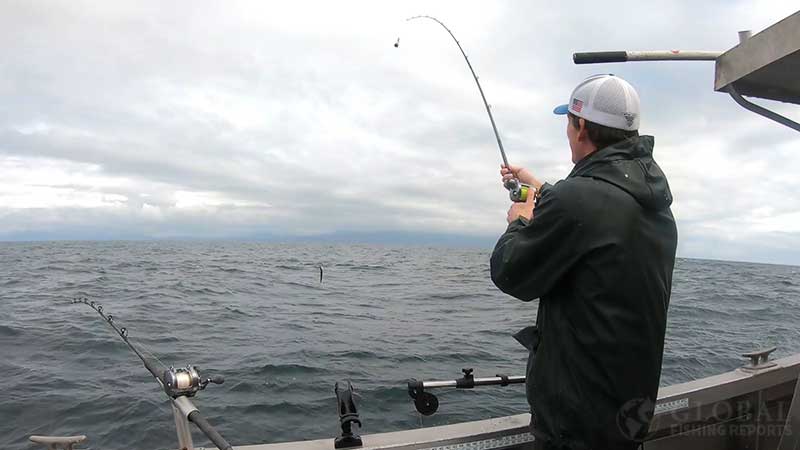
Mooching rigs can catch lingcod. However, if you are targeting lingcod the rig should stay be near the bottom. This can be done at a depth of less than 150 feet when the current is not very strong. Once you feel the rig hit the bottom reel up slowly for about 20 feet and then send it back down. This is best to do when anchored as the rig will be less likely to get snagged. When drifting try and keep the rig 5-10 feet from the bottom so the fish can see it but still not get snagged. The main problem with this style of fishing is you will catch tons of rockfish and small halibut as well. If you just want lingcod larger baits are typically a better option.
In the video above I show how to mooch. This is typically done for salmon from the surface to mid-depths of the water column. If you let the bait go all the way to the bottom it is very likely you will also catch lingcod, rockfish, and halibut. If you are on a sand or gravel flat fishing near the bottom it is also a good way to catch king salmon.
Types of Cod
Lingcod
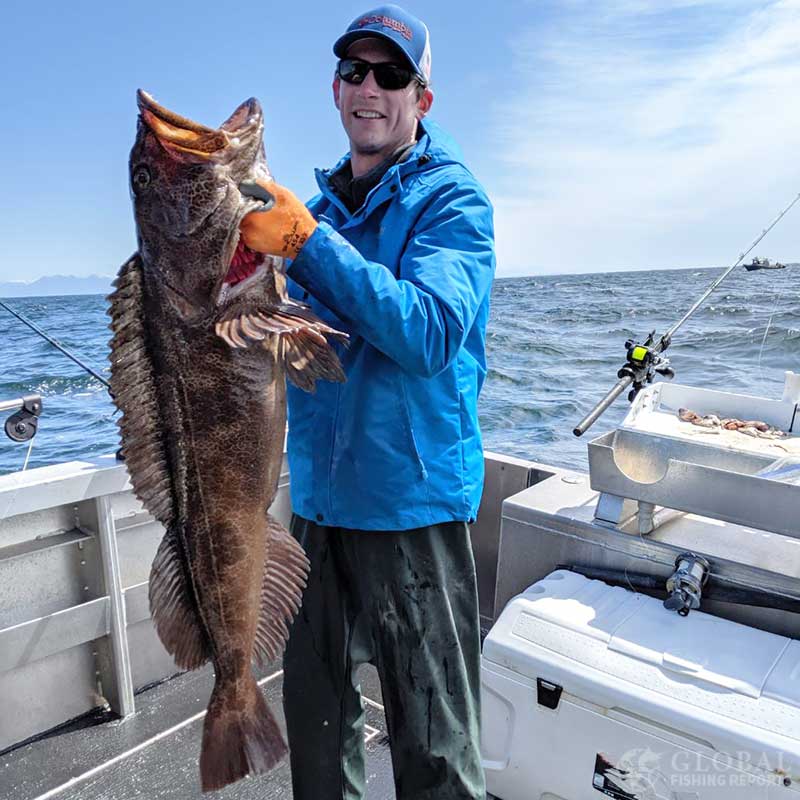
Lingcod is the largest fish in the greenling family and has a giant mouth and huge teeth. It is actually not related to cod or a ling fish. The IGFA world record is 82 pounds 9 ounces and was caught out of Homer Alaska. The fish had a length of 55 inches. Running fishing charters in Sitka Alaska it was not uncommon for clients to catch monster-sized lingcod.
Due to their large mouth full of teeth, long dorsal fin, and tail, large lingcod are often called seadragons. Lingcod do not have a swimbladder. This makes it so the fish can be released without a fish descender. The fish can be brought on the boat for a quick picture and then swim away strong. Rockfish have a swimbladder and suffer much more from barotrauma when brought up from deep depths. These fish are required to be released with a fish descender.
When catching a lingcod at deep depths over 200 feet the fish still show little to no signs of barotrauma. This is good as lingcod are typically regulated as a slot fish where most of them have to be released.
In the video above I am fishing out of Sitka Alaska. We catch king salmon, halibut, and lingcod. While fishing we also see sea lions, and orcas which are called killer whales.
Pacific Cod
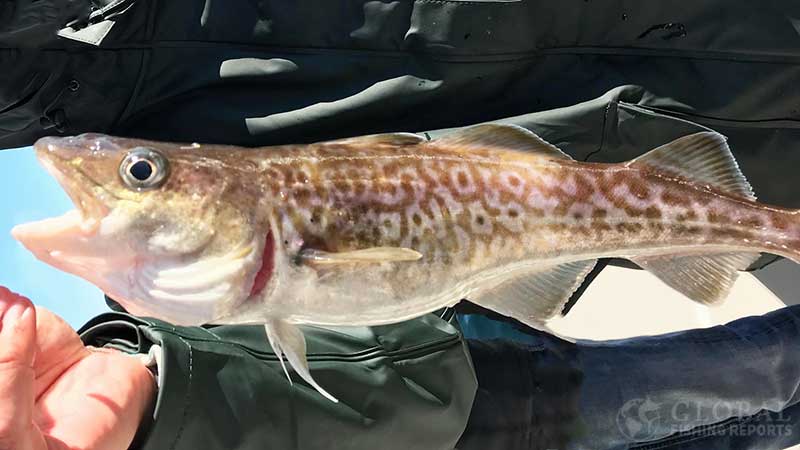
Pacific cod can be caught on a fishing rod and reel. It can also be caught on a long line by commercial fishing boats. Most of the catch that is brought to market is done by the trawl fishery by dragging nets deep along the ocean floor. According to NOAA fisheries stock smart data, in 2020 there were over 185,000 metric tons of Pacific cod caught in Alaska. This was 14,249 tons in the Aleutian Islands, 155,629 tons in the Bering Sea, and 15,723 tons in the Gulf of Alaska.
Pacific cod can be recognized by its front whiskers, white lateral line, and light brown mixed with a gray checkered patterned on its back. Sometimes Pacific cod is called grey cod or greyfish. The IGFA world record for Pacific cod is 38 pounds 9 ounces and was caught off the coast of Japan. In the picture above is a small Pacific cod I caught while fishing in Juneau Alaska.
Alaskan Pollock
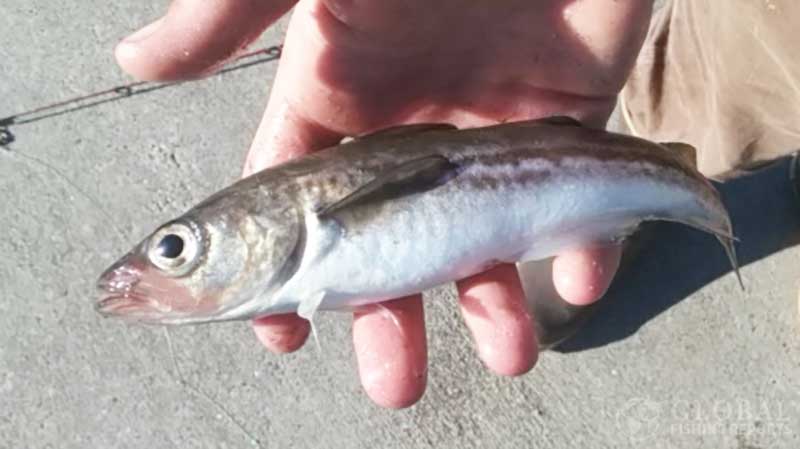
Alaskan pollock is a species of cod. In the picture above is a small pollock that was caught on a zabiki rig in a harbor in Juneau Alaska. This one was caught so it could be used as fresh halibut bait. Most pollock is commercially caught by trawlers using large nets.
Pollock from Alaska is actually the most widely used fish for fish sandwiches and fish sticks. According to NOAA fisheries stock smart data in 2020, there were over 1.5 million metric tons of pollock harvested in Alaska. This was 1,409, 230 tons in the Bearing Sea and 107,471 tons in the West Yakutat Gulf of Alaska.
The IGFA world record for Alaskan pollock is 8 pounds and was caught in Kachemak Bay Alaska. The largest type of pollock is just called pollock and has a world record catch size of 50 pounds. It was caught off the coast of Norway. European pollock has a world record catch size of 27 pounds 6 ounces and was caught off the coast of the United Kingdom.
Black Cod, Sablefish
Black cod has a common name of sablefish. However, most anglers and commercial fishermen just refer to it as black cod. The world record black cod was 35 pounds 3 ounces and was caught out of Elfin Cove Alaska. A more common size of black cod to catch is 5-10 pounds.
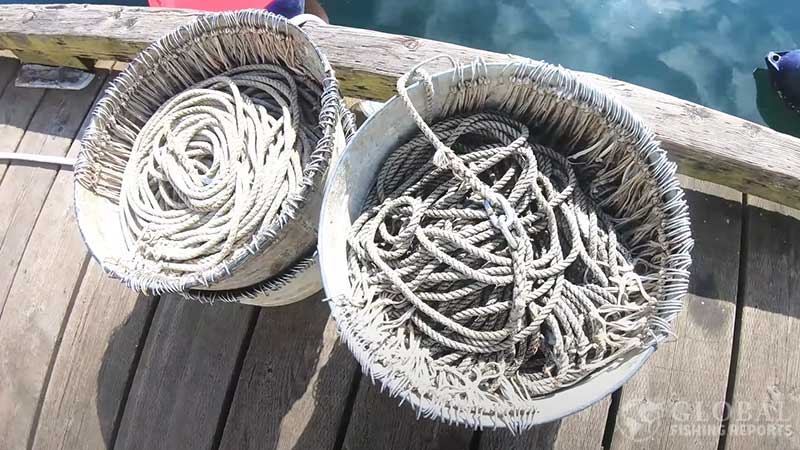
In the photo is a set of hooks for black cod commercial long line fishing. Black cod is typically caught by lone liners making sets with thousands of hooks in deep water. Each set consists of around 20 metal tubs worth of line which can be over 3 miles long. Typical fishing depths are between 275 and 350 fathoms. Which is a depth range of 1,650 to 2,100 feet. Black cod can also be caught in slinky pots or crab pots which act like a huge minnow trap.
In 2020 around 19,000 metric tons of black cod were caught in the Bearing Sea and around 3,800 metric tons were caught along the Pacific coast. Black cod can also be caught by sport fishing anglers and this is typically done with electric reels because the fish are caught in waters over 600 feet deep.
Atlantic Cod
According to NOAA fisheries stock smart data Atlantic cod was historically a great fishery, however, the biomass estimates are currently really low. In 2020 less than 1,300 metric tons were caught total in the Georges Bank and the Gulf of Maine. In previous years for example in 1984, over 105,000 metric tons were harvested just in the Eastern Georges Bank. What is not good is that the 2021 biomass estimate of Atlantic cod for the Eastern Georges Bank is only 4,640 metric tons.
The IGFA world record for Atlantic Cod is 103 pounds 10 ounces and was caught off the coast of Norway. This makes it the largest certified catch using a rod and reel of all the cod species. However, most cod are caught in nets rather than line and reel.
Lingcod Teeth
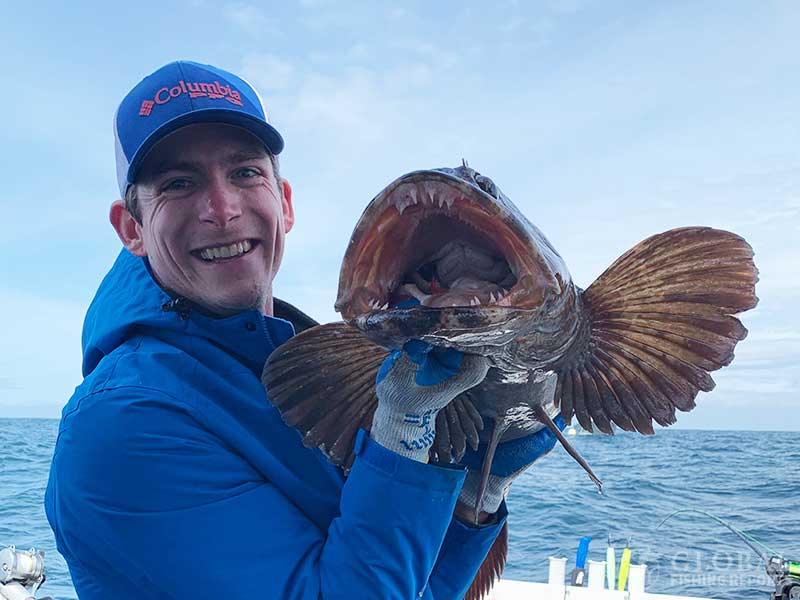
In the photo, I am holding a large lingcod with its mouth open. This is a fun photo to take is it looks like we are both smiling. Also with the fish’s large pectoral fins, it looks like the fish is waving hi.
Also, it shows that its mouth is about the size of my head. In the photo, you can see the top and bottom teeth as well as the upper teeth in the pharyngeal jaw. This fish was safely released after the picture was taken.
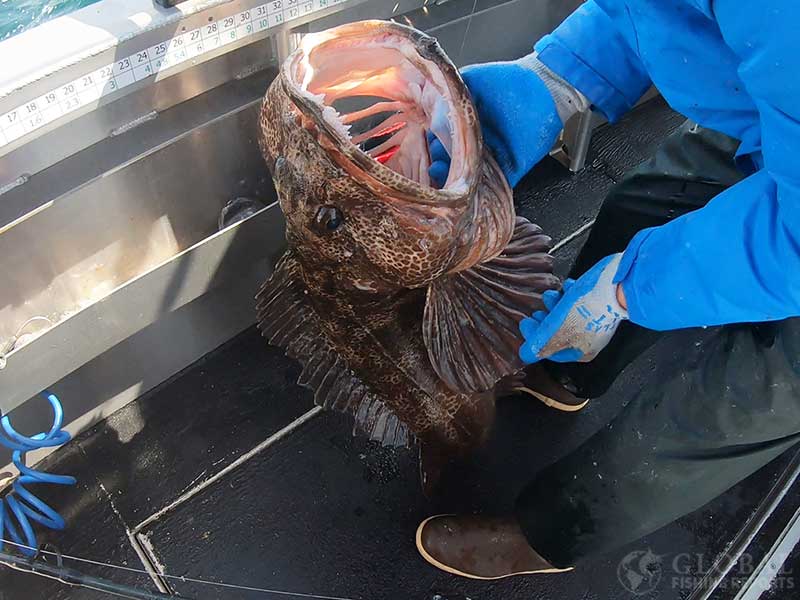
The photo above shows the large mouth and teeth of this 45-inch lingcod. Lingcod can be picked up by grabbing the lower jaws in front of the gills. Just make sure not to apply pressure to the gills as this is a sensitive area for fish.
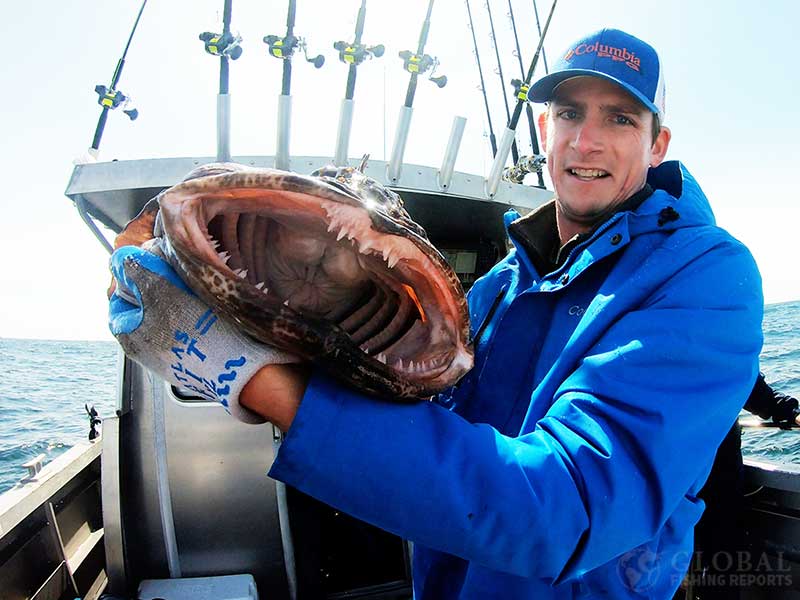
Lingcod have a giant mouth like bass and have fanglike teeth similar to a barracuda. This allows them to catch and swallow very large fish. The top of the jaw has over ten large fang-like teeth. The bottom jaw has over 25 fang-like teeth. Overall an adult lingcod has over 500 teeth. These teeth are primarily along the front and lower jaw lines. However, there is actually a second set of pharyngeal jaws. This set of jaws is deeper in the throat and behind the eyes of the lingcod.
A lingcod tooth research study showed that the fish lose about 3.6 percent of their teeth each day. This means a lingcod will lose 18 or more teeth per day. These are mostly the smaller teeth within the mouth. Lingcod do not grow multiple rows of teeth for replacement like shark teeth. The study also showed that each tooth is grown at a specific location and does not migrate. An interesting finding is that the teeth will fall out regardless of whether the fish is feeding. I would have thought the teeth would only grow new teeth as needed.
Size of Lingcod
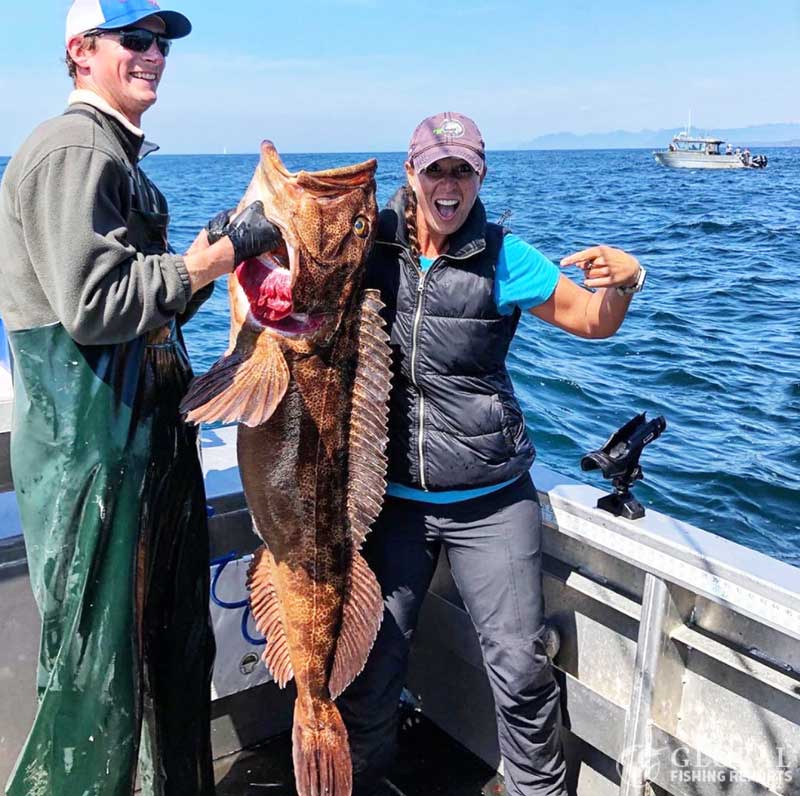
In the video above I show lots of things to do in Sitka Alaska including fishing for lingcod. Other activities include whale watching, the fortress of the bears, the raptor center, camping, and going hiking.
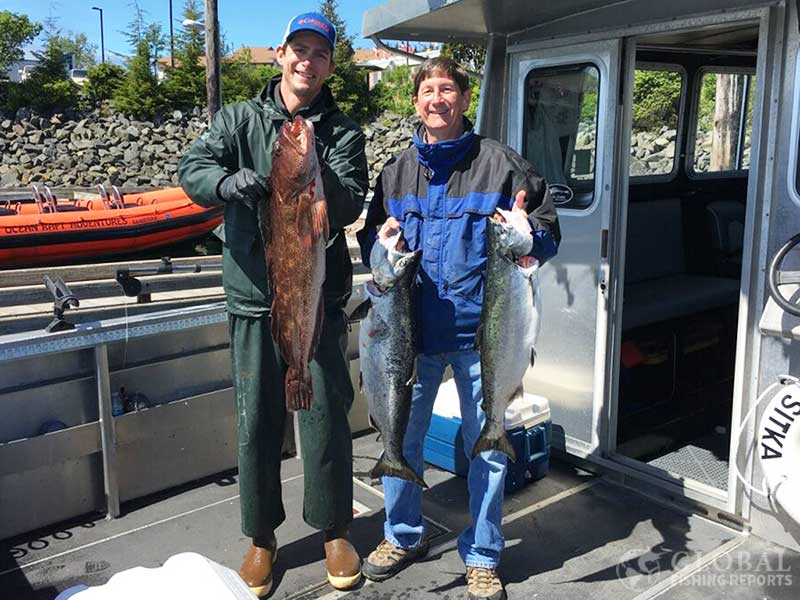
In the photo above I am holding a keeper-size lingcod in Sitka Alaska. It is actually pretty lucky when you catch a lingcod within the slot limit of 30-40 inches. The slot limit use to be 30-35 inches in Sitka which made it pretty difficult to catch a fish within the slot. This lingcod was caught while trolling for king salmon on a downrigger.
Trolling for Lingcod
Lingcod are typically caught by sportfishing anglers by anchoring the boat and setting down large baits. However, it is also common to catch smaller lingcod under 40 inches when trolling with herring near the bottom with a downrigger. Metal spoons, jigs, hoochies, and tube baits will also catch lingcod but I prefer to use fresh bait.
In the video, I show how to use downriggers for trolling. I was using Scotty electric downrigger with 15-pound lead weights. When targeting bottom fish it is important to keep the bait within 10 feet of the bottom. This is done by knowing the depth of the water with a fish finder sonar. Then the downrigger line depth can be set at the depth or even 10-20 feet deeper depending on the depth and troll speed. This is because the line blowback causes it to be at an angle that requires more line to reach the bottom. Just make sure to bring up the riggers before slowing down the boat. If this is not done the downrigger balls can hit the bottom and break off.
Food Quality of Lingcod
When many people think of lingcod they think of the cod that is used in Mcdonald’s fish sandwiches or fish sticks. However, fish sandwiches and fish sticks today are most likely made with pacific cod or Alaskan pollock. A much smaller percentage of these types of meals are made with Atlantic cod, haddock, or lingcod. For comparison around 800 metric tons of lingcod were commercially caught in Alaska in 2021 compared to 1.5 million, metric tons of Alaskan pollock. That means that not even 0.1 percent of fish sandwiches are lingcod.
This is a white flaky fish that is most similar to halibut or large pelagic rockfish. It can be fried for fish and chips or it can be baked, grilled, or broiled. Some lingcod had a blue tint or green tint to the fish and fillets. Most people say as it cooks it will turn white and is safe to eat. I have seen a green lingcod before and it defiantly looked strange to me. Lingcod can have worms so this is something to look out for especially on larger fish.
Lingcod Fishing Regulations
Around 40 percent of lingcod harvested was done by recreational and sportfishing anglers. The fishing regulations vary by state and regulations even vary by fishing area within the state.
In California, for 2022 the daily limit is 2 fish per day over 22-inches. The fish can not be kept if it is caught seward of the rockfish conservation area boundary line. This is around 50 fathoms or 30o feet. This means that the fish can not be kept if is caught deeper than 300 feet. This is to discourage people from fishing at deep depths where rockfish that are accidentally caught will likely die.
Oregon, lingcod season for 2022 is from July 1 to August 31. The daily limit is 2 fish over 22 inches. In order to keep the fish, it must be caught inside the 40-fathom line which is 240 feet.
For Washington state in 2022, the season is from March 12 to October 15th. Two lingcod can be caught per person with no size limit. There are restricted areas though so look into the regulations exactly where you will be going fishing.
In Alaska the regulations depend on the area and whether the angler is a resident or non-resident. For Alaska, residents 1 fish of any size can be caught per day. There is also a restriction that a person can only be in possession of 2 fish.
For non-residents, 1 fish can be caught per day and 2 fish can be caught per year. Only one of the fish can be over 55 inches. The other fish has to be between a slot of 30-35, 30-40, or 30-45 inches depending on the area being fished.
As the world record lingcod was 55 inches it is unlikely to catch a lingcod over 55 inches. However, the regulations make it so if you do catch one this large it can be kept as long as it is within the open fishing season.
Other Target Species
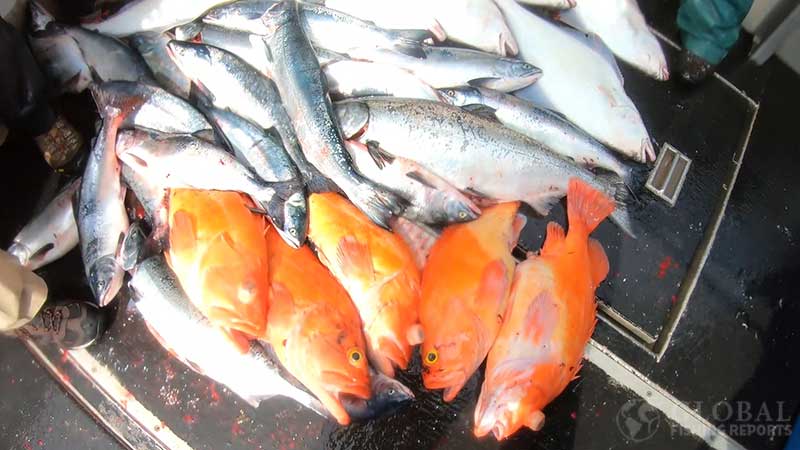
In the picture above are fish caught and kept in one day when fishing in Sitka Alaska. There are actually no lingcod caught and kept. That is because lingcod is not typically a target species. On most charters, anglers try and catch their limit of king salmon, silver salmon, and halibut. Yelloweye and seabass are a bonus if there is time. The slot size limit on lingcod makes it so that it is not typically worth trying to target lingcod. However, catching the large seadragons is super fun, and catching slot fish is defiantly a bonus fish that is nice to catch.
Captain Cody has worked on charter fishing boats in the Florida Keys, Virgin Islands, and Alaska. Growing up in Pennsylvania Cody has also done extensive freshwater fishing including bass fishing tournaments. Cody strives to provide detailed information about the best fishing gear and tactics to help both novice and experienced anglers have a more productive and enjoyable time on the water. Cody also has a background in aerospace engineering and neuroscience but really only takes pride in being good at one thing and that is fishing!
